北师大版(2019)必修第三册:Unit 7 Art Lesson 3 A Musical Genius 课件(32张ppt)
文档属性
| 名称 | 北师大版(2019)必修第三册:Unit 7 Art Lesson 3 A Musical Genius 课件(32张ppt) | 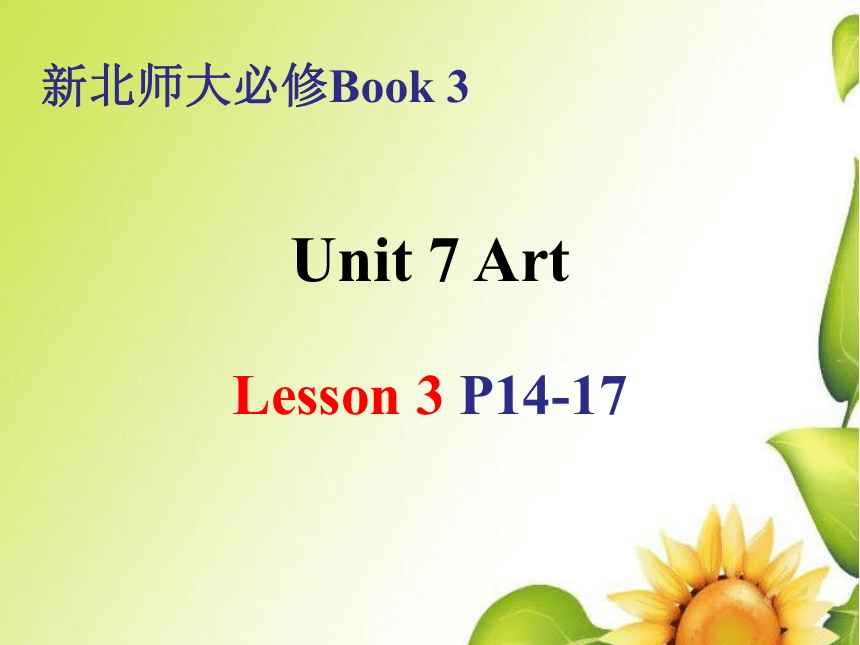 | |
| 格式 | pptx | ||
| 文件大小 | 1.5MB | ||
| 资源类型 | 教案 | ||
| 版本资源 | 北师大版(2019) | ||
| 科目 | 英语 | ||
| 更新时间 | 2022-11-05 18:21:17 | ||
图片预览

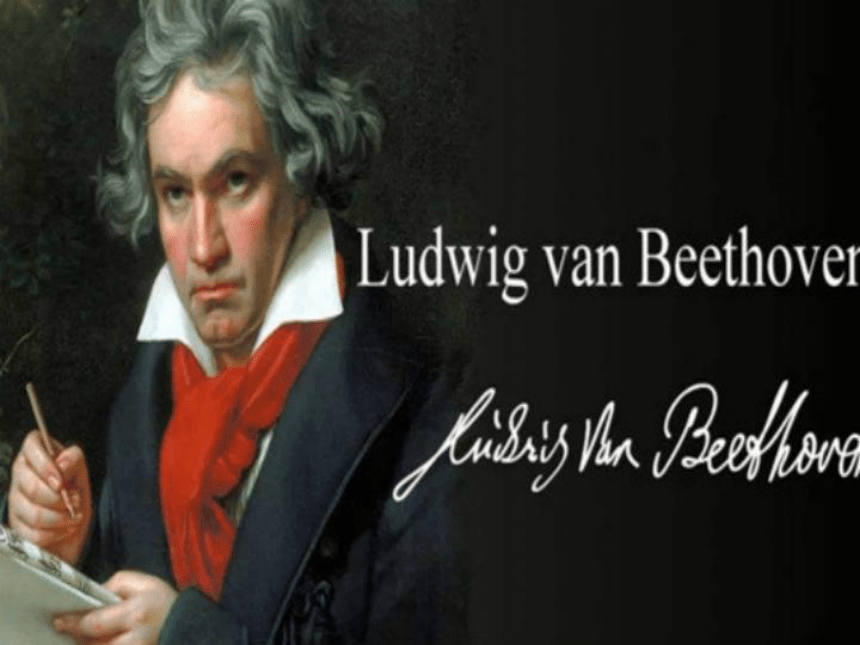
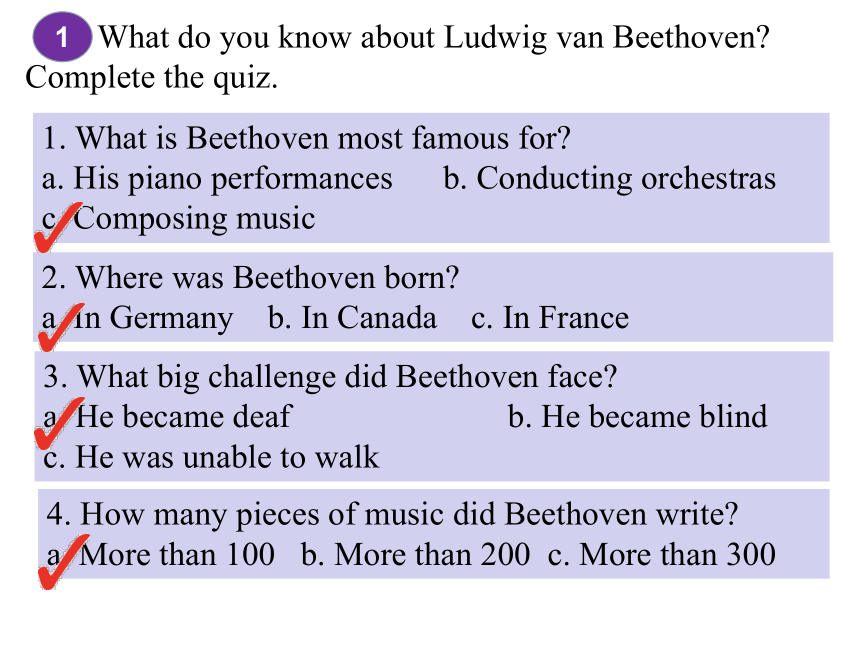
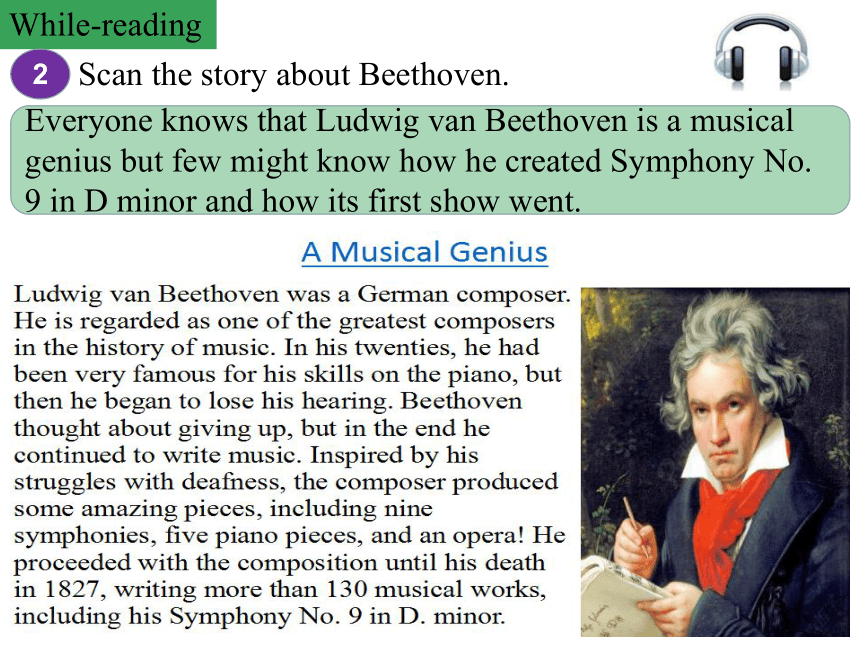
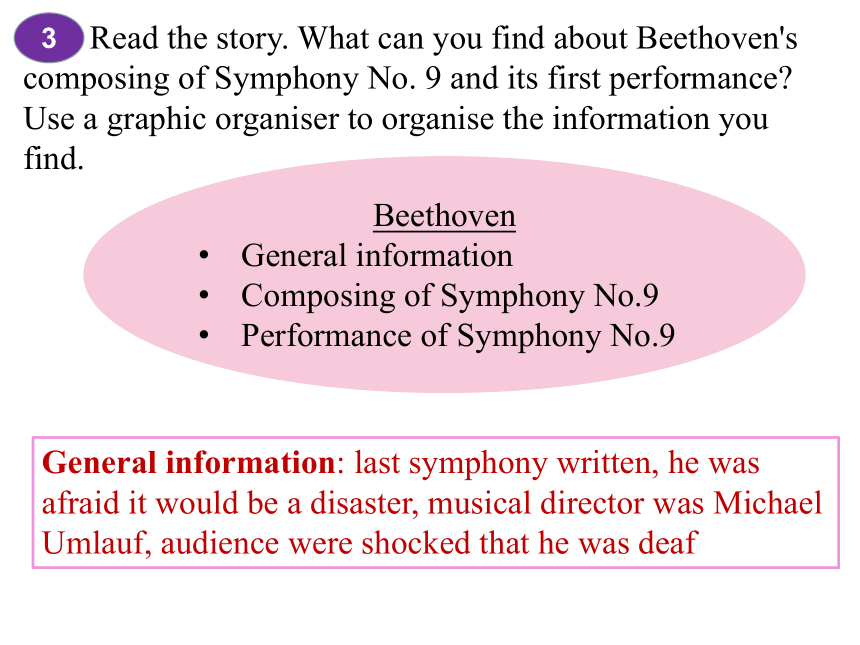


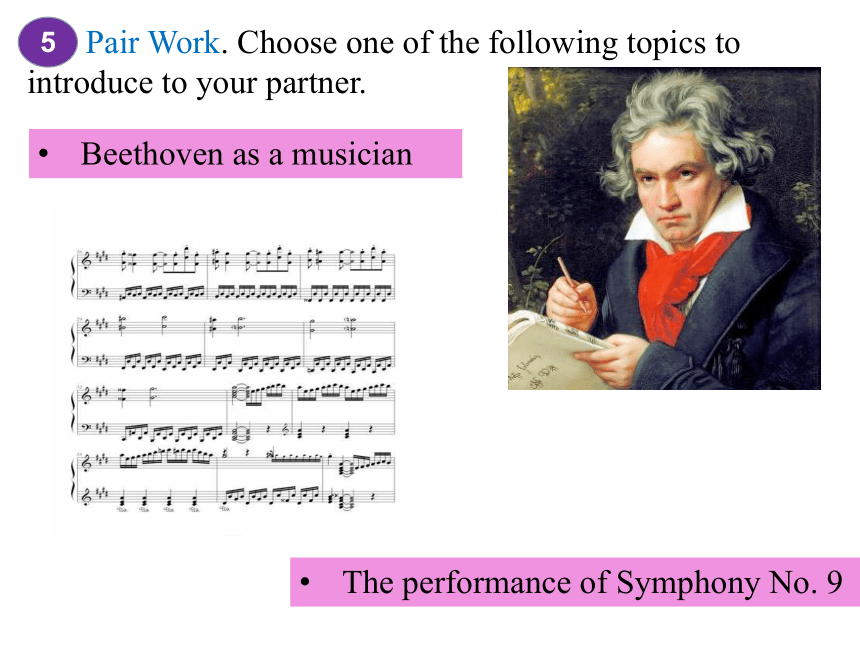
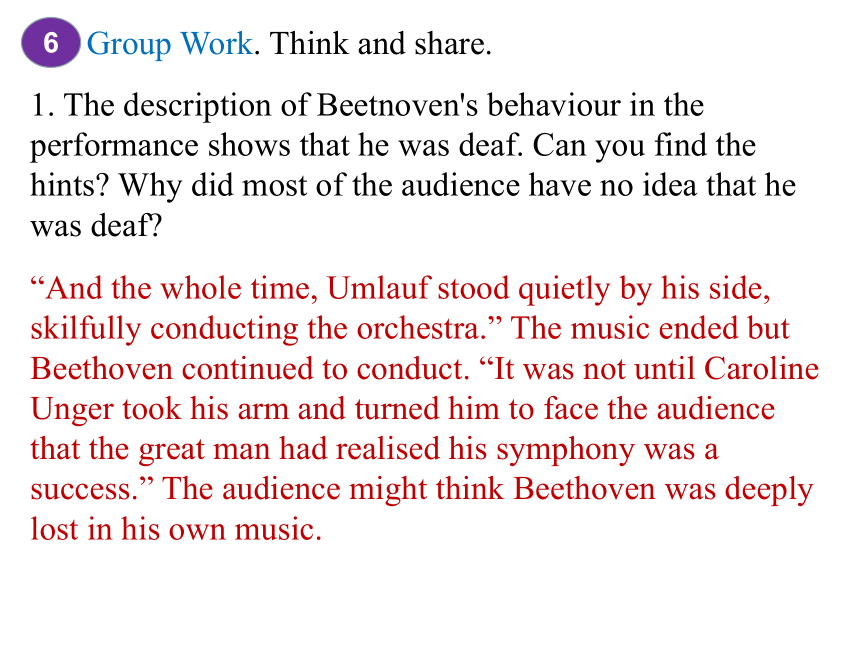
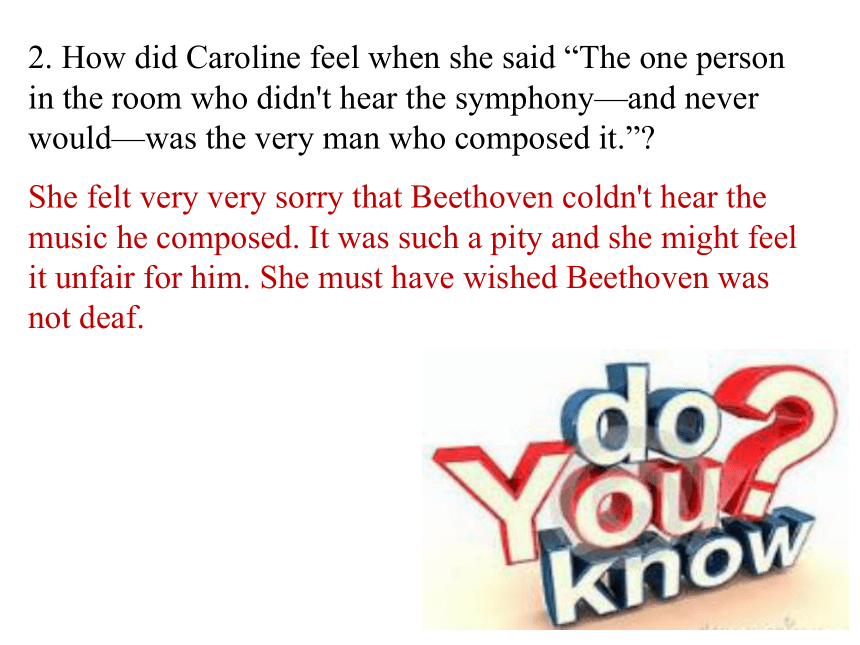
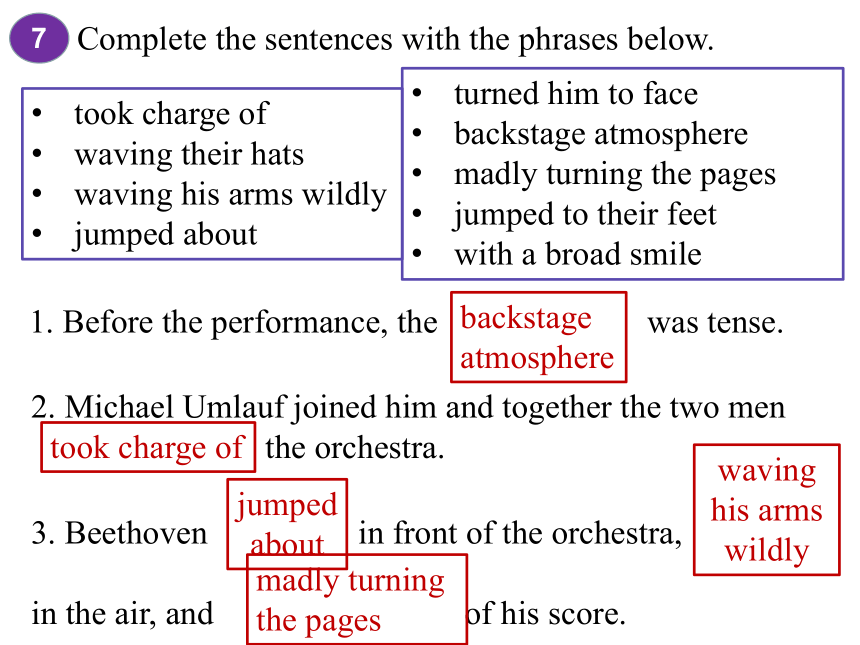
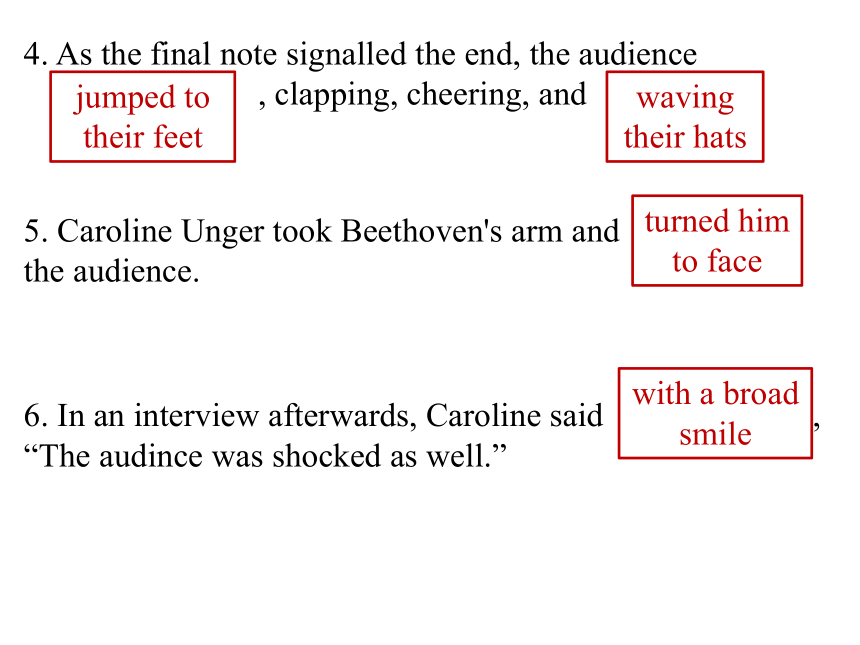
文档简介
(共32张PPT)
Lesson 3 P14-17
新北师大必修Book 3
Unit 7 Art
1
What do you know about Ludwig van Beethoven Complete the quiz.
1. What is Beethoven most famous for
a. His piano performances b. Conducting orchestras
c. Composing music
2. Where was Beethoven born
a. In Germany b. In Canada c. In France
3. What big challenge did Beethoven face
a. He became deaf b. He became blind
c. He was unable to walk
4. How many pieces of music did Beethoven write
a. More than 100 b. More than 200 c. More than 300
While-reading
Scan the story about Beethoven.
2
Everyone knows that Ludwig van Beethoven is a musical genius but few might know how he created Symphony No. 9 in D minor and how its first show went.
Read the story. What can you find about Beethoven's composing of Symphony No. 9 and its first performance Use a graphic organiser to organise the information you find.
3
Beethoven
General information
Composing of Symphony No.9
Performance of Symphony No.9
General information: last symphony written, he was afraid it would be a disaster, musical director was Michael Umlauf, audience were shocked that he was deaf
Composing of Symphony No.9: took several years, completed in Vienna
Performance of Symphony No.9: For more than an hour, Beethoven jumped about in front the orchestra, waving his arms widly in the air, and madly turning the pages of his score, The whole time, Umlauf stood quietly by his side, skillfully guiding the orchestra through the most amazing piece of music the world had ever know.
Skill Builder
Graphic Organisers
Graphic Organisers are a pictorial way of organising and illustrating information in a text. These include flow charts, tables and diagrams.
Determine the type of the text (e.g. narrative, argumentation, description, or exposition).
Analyse the writing technique. Does the text include sequencing, facts and opinion, cause and effect Does it compare and contrast
Determine which type of graphic organiser will illustrate the text in the most effective way.
Answer the questions based on your notes. Read the story again if needed.
4
1. When and how was Symphony No. 9 completed What was Beethoven thinking when he finished the symphony
2. How do you think Beethoven felt while he was conducting the orchestra Find evidence from the text.
Personally, Beethoven was very excited when conducting the ninth symphony.
One day in February 1824, the famous German composer's ninth symphony was finally completed, Beethoven tried to imagine how people would respond when they heard it for the first time.
Pair Work. Choose one of the following topics to introduce to your partner.
5
Beethoven as a musician
The performance of Symphony No. 9
Group Work. Think and share.
6
1. The description of Beetnoven's behaviour in the performance shows that he was deaf. Can you find the hints Why did most of the audience have no idea that he was deaf
“And the whole time, Umlauf stood quietly by his side, skilfully conducting the orchestra.” The music ended but Beethoven continued to conduct. “It was not until Caroline Unger took his arm and turned him to face the audience that the great man had realised his symphony was a success.” The audience might think Beethoven was deeply lost in his own music.
2. How did Caroline feel when she said “The one person in the room who didn't hear the symphony—and never would—was the very man who composed it.”
She felt very very sorry that Beethoven coldn't hear the music he composed. It was such a pity and she might feel it unfair for him. She must have wished Beethoven was not deaf.
Complete the sentences with the phrases below.
7
took charge of
waving their hats
waving his arms wildly
jumped about
turned him to face
backstage atmosphere
madly turning the pages
jumped to their feet
with a broad smile
1. Before the performance, the was tense.
2. Michael Umlauf joined him and together the two men
the orchestra.
3. Beethoven in front of the orchestra,
in the air, and of his score.
backstage atmosphere
took charge of
jumped about
waving his arms wildly
madly turning the pages
4. As the final note signalled the end, the audience
, clapping, cheering, and
5. Caroline Unger took Beethoven's arm and the audience.
6. In an interview afterwards, Caroline said , “The audince was shocked as well.”
jumped to their feet
waving their hats
turned him to face
with a broad smile
Post-reading
Pair Work. Which part of the story about Beethoven impressed you most Why
10
When Beethoven began to lose his hearing, he didn't give up writing music. This part impressed me most, because Beethoven delivered so much energy to me when facing difficulties.
Find some pieces of Beethoven's music online. Discuss how you feel when listening to his music.
11
How does the music make you feel
What does it remind you of
Do you like it or not Support your answer.
Try to figure out the answers of the following questions when listening to music.
Grammar P17
新北师大必修Book 3
Unit 7 Art
Lead-in
Complete the Word Builder. Use a dictionary to help you.
8
Noun Verb Adjective
music musician ×
composition ×
performance ×
produce
× conduct ×
hesitate
joy enjoy
respond
composer
performer
producer
conductor
hesitation
response
compose
perform
musical
productive
hesitated
joyous
responsive
production
Word Builder
Complete the sentences with the correct form of the words in the Word Builder.
9
1. It has always been my dream to ___________ an orchestra.
2. The musician ____________ with nervousness before he began to play.
3. Beethoven is recoginsed as a ____________genius by people around the world.
4. Beethoven is the ___________of Symphony No.9 in D minor.
5. To his mother's ________, he won first prize.
conduct
hesitated
musical
composer
joy
6. She told me about the wonderful ___________ that she had been to last week.
7. The audence's __________ to the performance of the symphony was extraordinary.
8. Though Beethoven lost his hearing, he __________ some amazing pieces of music.
performance
response
produced
一. 派生法
在词根前面加前缀或者在词根后面加后缀,从而构成一个和原单词意义相近或者相反的新词。
1. 前缀
前缀一般改变单词的意义,不改变词性(除少数英语前缀外)
1)表示否定意义的前缀
dis-, il-, in-, ir-, mis-, non-, un-等,在单词前加这类前缀常构成与该词意义相反的新词。
例如; like-dislike
happy-unhappy
existent-nonexistent
understand-misunderstand
构词法(Word Building)
2) 表示其他意义的前缀:
a- (多构成表语形容词), anti-(反对), auto-(自动), co-(共同), en-(使), inter-(互相), re-(又;再), sub-(下面的;次;小), tele-(强调距离)等。
例如:like-alike
war-antiwar
matic-automatic
worker-coworker
large-enlarge
national-international
union-reunion
way-subway
phone-telephone
2. 后缀
后缀一般改变单词的词性,少数后缀会改变单词的词义。
1)构成名词的后缀
-tion(动作;过程), -ness(性质;状态), -ment(性质;状态), -ian(精通……的人), -ist(专业人员), -er/or(从事某事的人)
例如:produce-production
deaf-deafness
move-movement
music-musician
femine-feminist
lead-leader/direct-director
2) 构成动词的后缀
-en(多用于形容词之后), -fy(使……化), -ize(使……成为)
例如:sharp-sharpen
beauty-beautify
real-realize
3)构成形容词的后缀
-al/able (有……能力的), -ive(性质;倾向), -ous(具有……), -ful(充满……), -less(表示否定)
music-musical
act-active
joy-joyous
use-useful
home-homeless
二. 合成法
两个单词连在一起合成新词,前一个词修饰或限定后一个词。
1. 合成名词
例如:birthplace / grown-up / background
2. 合成形容词
例如:outstanding / takeaway
3. 合成动词
例如:overcome / undercharge / outweigh
1. 动词转换为名词
例如:I think we'd better finish the talk now.
2. 名词转换为动词
例如:He has booked the tickets.
三. 转换法
单词词形不变,词性发生转换。
3. 形容词转化为动词
例如:We'll try our best to better our living conditions.
4. 形容词转化为名词
例如: The girl in red looks pretty.
四. 缩略法
将单词缩写,词义和词性保持不变。
1. 去头
例如:telephone-phone / airplane-plane
2. 去尾
例如: examination-exam / laboratory-lab
3. 去头去尾
例如:influenza-flu / prescription- script
1. This old build was built at the _________ (begin) of the 15th century.
2. You'd better give up smoking if you want to keep _________ (health).
3. The child looked at me _________ (strange).
4. The old man had no child so he suffered a lot from ___________ (lonely).
5. We must pay special attention to the ___________ (mystery) stranger.
6. To my _________ (happy), I passed the exam easily.
7. Mozart is one of the greatest ________ (music) in the world.
8. The __________ (discover) of gold on their land made the people rapidly rich.
beginning
healthy
strangely
loneliness
mysterious
happiness
musicians
discovery
Complete the sentences with the correct form of the words.
新北师大必修Book 3
Language points P14-15
Unit 7 Art
课文回顾:
The theatre's musical director, Michael, joined him and together the two men took charge of the orchestra.
句意:剧院音乐指挥迈克尔·奥姆洛夫也走上台和他一起指挥乐队。
take charge of 主管;负责,强调动作
in charge of 主管;负责,强调状态=in responsible for
例句:
The boss asked him to take charge of the office for a few days while he was away.
You are in charge of the job. How could you evade the issue
As the final, joyous note signalled the end of the symphony, the audience jumped to their feet, clapping, cheering, and waving their hats.
句意:最后,交响乐在欢快的音符中结束, 观众都跳了起来,鼓掌,欢呼,挥舞着他们的帽子。
signal v. 发信号;示意
n. 信号;红绿灯
signal sb. to do sth. 示意某人做某事
例句:
The submarine signalled for help.
We live too far from the city to get a strong television signal.
The conductor signalled the orchestra to rise.
It was not until Caroline Unger, one of the singers, took his arm and turned him to face the audience that the great man realised his symphony was a success.
句意:知道歌手卡罗琳·昂格尔拉着他的手臂转向观众,这位伟人才意识到他的交响乐取得了成功。
It is/was not until...that... 强调句型,意为:直到……才……
例句:
It was not until he finished his composition that his mom came back home.
It is not until the 1940s that such machine can be built.
It is not until recently that doctors find out the causes of this kind of disease.
Long sentence analysis.
1. As he proudly signed his name at the bottom of the page, Beethoven tried to imagine how people would respond when they heard it for the first time.
2. After all, what use is a conductor who could not hear his orchestra—even if he is a musical genius
时间状语从句
宾语从句
时间状语从句
主语从句
定语从句
让步状语从句
Thank you!
Lesson 3 P14-17
新北师大必修Book 3
Unit 7 Art
1
What do you know about Ludwig van Beethoven Complete the quiz.
1. What is Beethoven most famous for
a. His piano performances b. Conducting orchestras
c. Composing music
2. Where was Beethoven born
a. In Germany b. In Canada c. In France
3. What big challenge did Beethoven face
a. He became deaf b. He became blind
c. He was unable to walk
4. How many pieces of music did Beethoven write
a. More than 100 b. More than 200 c. More than 300
While-reading
Scan the story about Beethoven.
2
Everyone knows that Ludwig van Beethoven is a musical genius but few might know how he created Symphony No. 9 in D minor and how its first show went.
Read the story. What can you find about Beethoven's composing of Symphony No. 9 and its first performance Use a graphic organiser to organise the information you find.
3
Beethoven
General information
Composing of Symphony No.9
Performance of Symphony No.9
General information: last symphony written, he was afraid it would be a disaster, musical director was Michael Umlauf, audience were shocked that he was deaf
Composing of Symphony No.9: took several years, completed in Vienna
Performance of Symphony No.9: For more than an hour, Beethoven jumped about in front the orchestra, waving his arms widly in the air, and madly turning the pages of his score, The whole time, Umlauf stood quietly by his side, skillfully guiding the orchestra through the most amazing piece of music the world had ever know.
Skill Builder
Graphic Organisers
Graphic Organisers are a pictorial way of organising and illustrating information in a text. These include flow charts, tables and diagrams.
Determine the type of the text (e.g. narrative, argumentation, description, or exposition).
Analyse the writing technique. Does the text include sequencing, facts and opinion, cause and effect Does it compare and contrast
Determine which type of graphic organiser will illustrate the text in the most effective way.
Answer the questions based on your notes. Read the story again if needed.
4
1. When and how was Symphony No. 9 completed What was Beethoven thinking when he finished the symphony
2. How do you think Beethoven felt while he was conducting the orchestra Find evidence from the text.
Personally, Beethoven was very excited when conducting the ninth symphony.
One day in February 1824, the famous German composer's ninth symphony was finally completed, Beethoven tried to imagine how people would respond when they heard it for the first time.
Pair Work. Choose one of the following topics to introduce to your partner.
5
Beethoven as a musician
The performance of Symphony No. 9
Group Work. Think and share.
6
1. The description of Beetnoven's behaviour in the performance shows that he was deaf. Can you find the hints Why did most of the audience have no idea that he was deaf
“And the whole time, Umlauf stood quietly by his side, skilfully conducting the orchestra.” The music ended but Beethoven continued to conduct. “It was not until Caroline Unger took his arm and turned him to face the audience that the great man had realised his symphony was a success.” The audience might think Beethoven was deeply lost in his own music.
2. How did Caroline feel when she said “The one person in the room who didn't hear the symphony—and never would—was the very man who composed it.”
She felt very very sorry that Beethoven coldn't hear the music he composed. It was such a pity and she might feel it unfair for him. She must have wished Beethoven was not deaf.
Complete the sentences with the phrases below.
7
took charge of
waving their hats
waving his arms wildly
jumped about
turned him to face
backstage atmosphere
madly turning the pages
jumped to their feet
with a broad smile
1. Before the performance, the was tense.
2. Michael Umlauf joined him and together the two men
the orchestra.
3. Beethoven in front of the orchestra,
in the air, and of his score.
backstage atmosphere
took charge of
jumped about
waving his arms wildly
madly turning the pages
4. As the final note signalled the end, the audience
, clapping, cheering, and
5. Caroline Unger took Beethoven's arm and the audience.
6. In an interview afterwards, Caroline said , “The audince was shocked as well.”
jumped to their feet
waving their hats
turned him to face
with a broad smile
Post-reading
Pair Work. Which part of the story about Beethoven impressed you most Why
10
When Beethoven began to lose his hearing, he didn't give up writing music. This part impressed me most, because Beethoven delivered so much energy to me when facing difficulties.
Find some pieces of Beethoven's music online. Discuss how you feel when listening to his music.
11
How does the music make you feel
What does it remind you of
Do you like it or not Support your answer.
Try to figure out the answers of the following questions when listening to music.
Grammar P17
新北师大必修Book 3
Unit 7 Art
Lead-in
Complete the Word Builder. Use a dictionary to help you.
8
Noun Verb Adjective
music musician ×
composition ×
performance ×
produce
× conduct ×
hesitate
joy enjoy
respond
composer
performer
producer
conductor
hesitation
response
compose
perform
musical
productive
hesitated
joyous
responsive
production
Word Builder
Complete the sentences with the correct form of the words in the Word Builder.
9
1. It has always been my dream to ___________ an orchestra.
2. The musician ____________ with nervousness before he began to play.
3. Beethoven is recoginsed as a ____________genius by people around the world.
4. Beethoven is the ___________of Symphony No.9 in D minor.
5. To his mother's ________, he won first prize.
conduct
hesitated
musical
composer
joy
6. She told me about the wonderful ___________ that she had been to last week.
7. The audence's __________ to the performance of the symphony was extraordinary.
8. Though Beethoven lost his hearing, he __________ some amazing pieces of music.
performance
response
produced
一. 派生法
在词根前面加前缀或者在词根后面加后缀,从而构成一个和原单词意义相近或者相反的新词。
1. 前缀
前缀一般改变单词的意义,不改变词性(除少数英语前缀外)
1)表示否定意义的前缀
dis-, il-, in-, ir-, mis-, non-, un-等,在单词前加这类前缀常构成与该词意义相反的新词。
例如; like-dislike
happy-unhappy
existent-nonexistent
understand-misunderstand
构词法(Word Building)
2) 表示其他意义的前缀:
a- (多构成表语形容词), anti-(反对), auto-(自动), co-(共同), en-(使), inter-(互相), re-(又;再), sub-(下面的;次;小), tele-(强调距离)等。
例如:like-alike
war-antiwar
matic-automatic
worker-coworker
large-enlarge
national-international
union-reunion
way-subway
phone-telephone
2. 后缀
后缀一般改变单词的词性,少数后缀会改变单词的词义。
1)构成名词的后缀
-tion(动作;过程), -ness(性质;状态), -ment(性质;状态), -ian(精通……的人), -ist(专业人员), -er/or(从事某事的人)
例如:produce-production
deaf-deafness
move-movement
music-musician
femine-feminist
lead-leader/direct-director
2) 构成动词的后缀
-en(多用于形容词之后), -fy(使……化), -ize(使……成为)
例如:sharp-sharpen
beauty-beautify
real-realize
3)构成形容词的后缀
-al/able (有……能力的), -ive(性质;倾向), -ous(具有……), -ful(充满……), -less(表示否定)
music-musical
act-active
joy-joyous
use-useful
home-homeless
二. 合成法
两个单词连在一起合成新词,前一个词修饰或限定后一个词。
1. 合成名词
例如:birthplace / grown-up / background
2. 合成形容词
例如:outstanding / takeaway
3. 合成动词
例如:overcome / undercharge / outweigh
1. 动词转换为名词
例如:I think we'd better finish the talk now.
2. 名词转换为动词
例如:He has booked the tickets.
三. 转换法
单词词形不变,词性发生转换。
3. 形容词转化为动词
例如:We'll try our best to better our living conditions.
4. 形容词转化为名词
例如: The girl in red looks pretty.
四. 缩略法
将单词缩写,词义和词性保持不变。
1. 去头
例如:telephone-phone / airplane-plane
2. 去尾
例如: examination-exam / laboratory-lab
3. 去头去尾
例如:influenza-flu / prescription- script
1. This old build was built at the _________ (begin) of the 15th century.
2. You'd better give up smoking if you want to keep _________ (health).
3. The child looked at me _________ (strange).
4. The old man had no child so he suffered a lot from ___________ (lonely).
5. We must pay special attention to the ___________ (mystery) stranger.
6. To my _________ (happy), I passed the exam easily.
7. Mozart is one of the greatest ________ (music) in the world.
8. The __________ (discover) of gold on their land made the people rapidly rich.
beginning
healthy
strangely
loneliness
mysterious
happiness
musicians
discovery
Complete the sentences with the correct form of the words.
新北师大必修Book 3
Language points P14-15
Unit 7 Art
课文回顾:
The theatre's musical director, Michael, joined him and together the two men took charge of the orchestra.
句意:剧院音乐指挥迈克尔·奥姆洛夫也走上台和他一起指挥乐队。
take charge of 主管;负责,强调动作
in charge of 主管;负责,强调状态=in responsible for
例句:
The boss asked him to take charge of the office for a few days while he was away.
You are in charge of the job. How could you evade the issue
As the final, joyous note signalled the end of the symphony, the audience jumped to their feet, clapping, cheering, and waving their hats.
句意:最后,交响乐在欢快的音符中结束, 观众都跳了起来,鼓掌,欢呼,挥舞着他们的帽子。
signal v. 发信号;示意
n. 信号;红绿灯
signal sb. to do sth. 示意某人做某事
例句:
The submarine signalled for help.
We live too far from the city to get a strong television signal.
The conductor signalled the orchestra to rise.
It was not until Caroline Unger, one of the singers, took his arm and turned him to face the audience that the great man realised his symphony was a success.
句意:知道歌手卡罗琳·昂格尔拉着他的手臂转向观众,这位伟人才意识到他的交响乐取得了成功。
It is/was not until...that... 强调句型,意为:直到……才……
例句:
It was not until he finished his composition that his mom came back home.
It is not until the 1940s that such machine can be built.
It is not until recently that doctors find out the causes of this kind of disease.
Long sentence analysis.
1. As he proudly signed his name at the bottom of the page, Beethoven tried to imagine how people would respond when they heard it for the first time.
2. After all, what use is a conductor who could not hear his orchestra—even if he is a musical genius
时间状语从句
宾语从句
时间状语从句
主语从句
定语从句
让步状语从句
Thank you!
同课章节目录
- Unit 7 Art
- Lesson 1 Masterpieces
- Lesson 2 Beijing Opera
- Lesson 3 A Musical Genius
- Unit 8 Green living
- Lesson 1 Roots and Shoots
- Lesson 2 Greening the Desert
- Lesson 3 "White Bikes" on the Road
- Unit 9 Learning
- Lesson 1 Active Learning
- Lesson 2 Language Learning Tips
- Lesson 3 The Secrets of Your Memory
